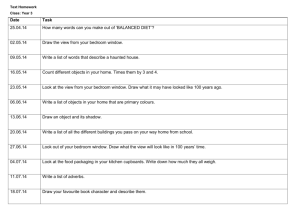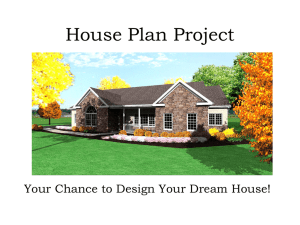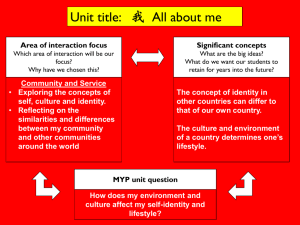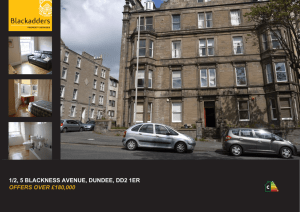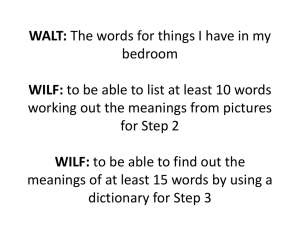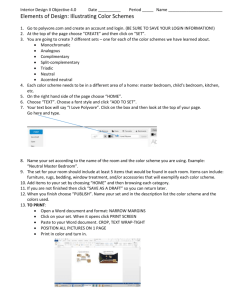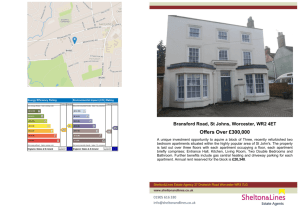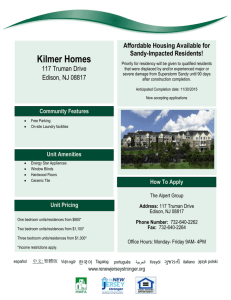Fulfillment of the Submitted in Partial I
advertisement
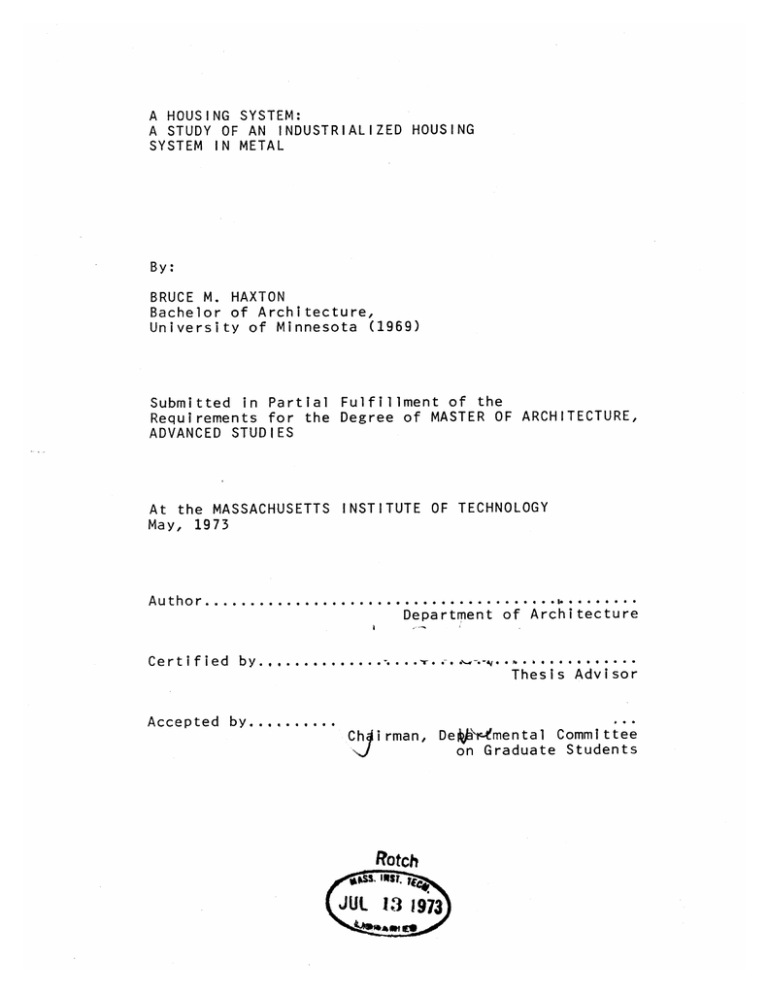
A HOUSING SYSTEM:
A STUDY OF AN INDUSTRIALIZED HOUSING
SYSTEM IN METAL
By:
BRUCE M. HAXTON
Bachelor of Architecture,
University of Minnesota (1969)
Submitted in Partial Fulfillment of the
Requirements for the Degree of MASTER OF ARCHITECTURE,
ADVANCED STUDIES
A t the MA SSACHUSETT S INST ITUTE OF TECHNOLOGY
May, 1973
Author..............
..
..
....
..
...
......
. -
...
Department of Arch itecture
Certified by.
..
..
..
..
.-
.
.
..-..
'
.
..
...
b.
.....
--
Thesis Advisor
Accepted by..........
Ch i rman,
-- Dew&icr.mental Committee
on Graduate Students
Rotch
JUL 13 1973
May 11,
1973
Dean William Porter
School of Architecture and Planning
Massachusetts Institute of Technology
Dear Dean Porter:
In partial
fulfillment of the requirements for the
degree of Master of Architecture, Advanced Studies, I
hereby submit this thesis entitled:
A HOUSING SYSTEM: A STUDY OF AN INDUSTRIALIZED HOUSING
SYSTEM IN METAL.
Respectfully,
Bruce M. Haxton
ACKNOWLEDGEMENTS
The author wishes to gratefully acknowledge the
following people, whose assistance and advice have
contributed significantly to the development of
this thesis.
Waclaw P. Zalewski
Professor of Architecture
Massachusetts Institute of Technology
Thesis Advisor
Eduardo Catalano
Professor of Architecture
Massachusetts Institute of Technology
Aurthor D. Bernhardt
Professor of Architecture
Massachusetts Institute of Technology
Ezra Ehrenkrantz
Visiting Professor
Massachusetts Institute of Technology
James Bock
Executive Vice President
Bock Industries Incorporated
TABLE OF CONTENTS
Ti tle Page
Letter of Submittal
Acknowledgements
Table of Contents
Abstract
Introduct ion
Design Analysis
Design Constraints
Methodology
Design Considerations
Areas for Further Study
User Requirement Study
Market Study
Design Study
Design Categories
Design Components
Delivery Components
Unit Plans
Unit Cluster Plans
Details
Unit Model
Bibliography
ABSTRACT
A HOUSING- SYSTEM:
A STUDY OF AN INDUSTRIALIZED
HOUSING SYSTEM IN METAL
By BRUCE M. HAXTON
Submitted to the Department of Architecture on May 11,
1973 in partial fulfillment of the requirements for the
degree of Master of Architecture, Advanced Studies.
The aim of this thesis
is to study an industrialized
housing system based on metal
framed housing modules.
These housing modules would be produced using assembly
line techniques and delivered to the site for erection.
The thesis contains three primary elements:
1) The user
requirement study, 2) The market study, and 3) The
design study.
The user requirement and market studies
were used to establish parameters for the design study.
The design study demonstrates how basic living elements
can be used to generate building modules that are delivered to the site to form dwelling units.
Thesis Supervisor: Waclaw P. Zalewski
Title:
Professor of Structures
INTRODUCT ION
1.1
The Problem
A multitude of building systems are being marketed
today to meet the numerous housing demands of the
nation.
Examples satisfy variations in family
size and income level as well as providing a range
of housing types. Mobile homes, for example, largely
focus on rural,
low-cost, single family housing. Con-
versely, modular housing Is oriented toward larger
extended families at a higher income level.
Other
systems have been developed for the urban apartment
dweller using steel and concrete technology.
Upon
invest.igating a selected sample, the author has
discovered inadeqacies in the design of these
systems.
It has been observed that many of these
systems are based on preconceived or poorly analyzed design parameters.
Program inconsistencies ex-
ist which reflect a lack of a systematic investigation of three essential aspects; 1) Projected needs
of the user; 2) An accurate assesment of market
conditions; and 3) The effective and efficient application of utilizing existing factory production
and distribution technology.
1.2
Obiective of the Studv
This thesis is intended to provide the designers
and producers of industrialized housing systems
with a methodology and design example for integrating assembly-line production techniques, effective marketing, and user requirements.
1.3
Methodology
Three primary elements form the thesis: 1) A user
requirement study, 2) A market study, and 3) An
illustrative design example.
The user require-
ment study and market study were used to establish
design categories which are used as parameters for
the design study.
1.4
Scope
The design proposal is based on factory produced
metal
framed housing modules.
These housing modules
would be transported to the building site to form
dwelling units of the following types:
1) Single
family detached, 2) Single-family attached, and
3) Multi-family low-rise up to three stories in
height.
DESIGN ANALYSIS
2.1
Design Constraints
Unit Constraints
One to four bedroom Configurations
Units limited to one floor only
Units must accommodate variations in floor
area and utilities
Housing types will encompass single-family
detached, single family attached, and
multi-family low-rise up to three stories in
in height
Site Planning Constraints
Units must form cluster arrangements
The system must be suitable for single site
application as well as multiple unit sites
Manufacturing Constraints
The system must be adaptable to assembly line
production techniques
The system should use existing manufacturing
technology and products
Transportation Constraints
The maximum shipping width
14'-0"
The maximum shipping length
70'-0"
The maximum shipping height
13'-6"
The maximum shipping weight
30 tons
2.2
Methodologv
The procedure was to establish the ranges of
various housing elements such as, living/dining
square-footage, that could then be broken down
into categories and used as design parameters.
Minimum user requirements and housing examples
were used to establish these ranges.
User Requirement Study
The User Requirement
Study is
divided into the
following categories: 1) Living room requirements,
2) Dining room requirements, 3) Bedroom requirements, 4) Kitchen requirements, and 5) Bathroom
requirements.
The primary source used for the study was the
Guide Criteria for the Design and Evaluation of
Operation Breakthrough: Volumell.- Multi-family
Low-rise.
performed by the Building Research
Division Team in 1970 and adopted by the U.S.
Department of Housing and Urban Development as
the criteria for Operation Breakthrough.
The study was used to generate and check room
sizes and shapes,
Market Study
The market study was accomplished by taking a
selected sample,
Dwelling unit groups of similar
bedroom counts formed subdivisions in the following categories: 1) Dwelling unit size, 2) LivIng and dining areas, 3) Kitchen counter length,
and 4)
Utilities.
Design Study
The user requirement and market studies were
used to form the range of various housing elements
to be used In the design study. The user requirements formed minimums while the market study
idenifled the the upper limits for each housing
element.
The ranges for each housing element
were then broken down into into categories within
each bedroom count.
Each category could be used
as a set of design parameters for a particular
unit design.
2.3
Design Considerations
Building Form
The cluster arrangement was used because it promotsocial
interaction and was conducive to providing
a hierarchy of spaces
The social
in planning arrangements.
basis for this type of housing is cover-
ed in Architectural
Enyironment and Our Mental
Health, by Clifford B. Moller.
Manufacturing Considerations
The use of existing materials would reduce the
-"tooling up"
aspect of production which could
otherwise be an inhibiting factor.
Box construction permits the highest degree of
industrialization possible and labor costs are
minimized.
The ample supply of metal
insures that material
costs will not seriously escalate in the future.
Metal
construction allows close tolerance levels
and rapid assembly.
Transportation Considerations
The use of the floor members as the chassis element for transportation allows a cost reduction.
The wheel and hitch assembly are returned to the
factory thus saving the cost of these items
over existing mobile home practices.
Marketing Considerations
The market network that has been established
by the mobile home industry could be used to
market this system.
Since the system encompasses both single family and multi-family structures a greater aggregation of the market is achieved.
Construction Considerations
The rigid frame structure promotes structural
continuity during the erection process.
The connections between units establishes a
structural continuity thus establishes
resistance to horizontal forces.
The use of steel promotes tolerance control.
The use of the metal frame allows easy erection
lifting with the metal column connections.
AREAS FOR FUTHER STUDY
Futher study is needed in the following areas:
Building Forms
Double loaded corridor configurations and two
story units should be investigated.
Criteria and options should be established for
intergrating more non-system elements into
the unit designs.
Structural and Code Requirements
Additional structural calculations and tes t i ng
should be made.
Fire testing and building code accepta nce should
be accomplished.
Market Studies
A more comprehensive market study should be made
taking a wider sampling.
A market anaylsis should be made of the specific
market area.
USER REQUIREMENT STUDY
COUCH
3'-0" X 6'-101
.......
...........
-----
----
-
. ... ......
.
... .. ... .. .. . ...............
.. .. ... . ... .. ... ..
.............
. ...............
..............
..............
..
..............
........... ..
.... .... ..... ....... ....
. .....
.................
..
..
I.......
.....
....
....
...
.....
...
.....
..
....
....
.......
..
......
. ..............
..
...I
....
..
...
....
.. ..............
....
..
...............
.............
...............
.................
..............
..
..............
..
...............
.............
...............
..............
...........................
..
.. ....
..........
..
.............
...............
....
..............
.................
......
I..........
..............
..
..............
....
.............
. ...............
....
..............
..
..............
.............
....
. ...............
.. ..............
1*'*"*""'*"""'*"""*"'*"'**
TWO EASY CHAIRS
2'-6" X 3'-0" each
DESK
1'-8" X 3'-6"
CHAIR
1'-6" X 1'-6"
n
- -
TELEVISION
1'-4" X 2'-8"
60"
24"1
36"
10'
3011
-.1
L
TABLE
1'-6" X 2'-6"
..................
............
..
................
.............
..
- ..
..
.........
..
..
. .............
.............
..
..
............
..
..
. .............
..
..
............
..
.............
..
. .............
............
..
..
.
..
............
..
..
.............
..
.
............
..
..
. .............
..
..
............
..........
..
..................
-- -----------..................
.................
..................
..................
..................
..................
..................
..................
..................
I
D
5'-0" to view
between facing seating
circulation between furniture
main circulation
diameter of conversation area
LIVING ROOM REQUIREMENTS
.....
......
F7LIZ..
I......
W ..
11'-0"
-- 4
4
4
12 '-8"
13'-O"
...
D...
LIVING ROOM ARRANGEMENT
TABLE FOR FOUR
3'-2" X 2'-6"
421
421
32"'
9'-4"
32"
L - .... - .... ..
8 -8
~-1
TABLE FOR SIX
3'-41"
X 41-0"
42"
10 '-2"
32"
4 21
321"
L ---
... ----------.
. - - -...
9 '-6"
TABLE FOR EIGHT
3'-4" X 6'-0"
42"
.....
]II
32
42"1
]II
..-... .
32" access .for seating
42' for serving
48" from table to base
cab Inets
12'-2"
32"
L--------------.-..-....-...........
--
--- -- --.--
_-_-_---
DINING ROOM REQUIREMENTS
..................
TWO TWIN BEDS
3'-3" X 6'-10"
.......................
........................
....................
.......................
.......................
........................
.......................
........................
.......................
........................
.................
.......................
........................
......................
........................
.......................
........................
.......................
........................
..........
..............
.......................
.......................
........................
...........
.........
.....................
...........
12
......
...
..
.
...
.
I----- ....
:12 .......................
...
....
.
.....
.............
..
..
.
.
...
.......................
.......................
................
......
.......................
..............
........
.......................
.................
I.....
.......................
.......................
.......................
.......................
.......................
..........
I............
..............
..........
........................
..............
.......................
.......................
.......................
........................
.......................
........................
.......................
1'
.......................
..........
...............
22"
4
L--- -----------------
10'-4
1
1
CR I B
2'-6" X 4'-6"
4'-4"
22"11
DRESSER
1 '-6"
X 4 '-4"
............................
....
... ...
... ... ..
. ....
.......
.. .
.
....
..
.. ... ...........................
... ..
... ..
... ...
.....
....
...
.......................
.
...............................
...............................
...............................
...............................
...............................
...............................
......................
...............................
...............................
...............................
3611
L ----------
41-611
J
TABLE
2'-6" X l'-8"
CHA I R
1'-6" X 1'-6"
....
L....-.........-..
I
L.. ... ..
DRESSING AREA
3'-6" X 3'-6"
PRIMARY BEDROOM
BEDROOM REQUIREMENTS
-4
12 ' -10"
11'-4"
14'-10"
r
.......................
....
.......
11'0ii
............
...............
.....
PRIMARY BEDROOM
-
BEDROOM ARRANGEMENT
..........I......
TWO TWIN BEDS
3'-3" X 6'-10" each
. .. ... .. .. .. .. ... .. ..
................
... .. .. .. .. ....
. .. ... ..
.......................
. .. .. .. .. ... .. ..
. ...
.. ...
..
.. ...
.. ..
.. ...
..
.. ..
.. ..
.. ..
. ..
. ...
..... .. .. .. .. ... . ... .. ..
.. ...... .. ..
777
. ..
.. ...
. ...
.. ...
.. ..
.. .. ...
. ...
.. ..
.. ..
.
... .. ..
.. .. ... .
.. .
. .. ... .. .. ... . ... ...........
. .. .. .. .. ... .. .. .. .. ...
.. . ... .. .. ... .. .. .. .. ..
...
. .. ..
.....
.. .. . ...
.. .. ...........
.. ..
. ...
.. ..
.. .
..
.. ..
.. ..
... ..
.. ..
.. .. .. .. ... .. ..
... .. .. ..
...............
........
2211 .. ................
1 2 11 8 - 8 11
112 .......................
......................
.......................
.......................
.......................
.......................
......................
.....................
I
.
...
...
.......................
.................
........
.......................
.......................
.......................
.......................
.......................
...................................
........
.......
2211
L------------------------101-411
ONE DOUBLE BED
(ALTERNATE)
4 1'-6" X 6'-10"
......................
.................................
.................................
.................................
.................................
.................................
.................................
.................................
.................................
.................................
.................................
.................................
....................
.......................
:12
22"
.................................
.................................
...........
................................
.................................
................................
.................................
................................
.....................
.....................................
8' -8"
.................................
.........................
..
..................
................
2211
L------------------
7 -14"
TWO DRESSERS
1'-6" X 4'-41" each
36" to use
I
~
36'
Second dresser is
desirable but not
required.
..... I
. . . .I..
.
... ... ... ... .
I .. . . .. . . . . .. . . . .
I . . . . .. . . . . ...
I
. .
I.. .. . . . . . .. *I. . .
I.
... . ...-. . .. ..- ...... .. ... .. - .L -
DESK AND CHAIR
1'-8" X 3'-6"
30" to use
30'!
DRESSING AREA
31-6"
L----------a
X 3'-6"
SECONDARY
DOUBLE
OCCUPANCY
BEDROOM
BEDROOM REQUIREMENTS
--
I---
11'-4"
-- -
-
4
11'-4"'
10' -0"
r--
.....
.. .. .. .
.. .... ...
. . .. .
.. .
..
. ....
..
. . . . . .
.. .
L
........
. .... .
......
..
10'
-4"
...............I
.
.~
BEDOO
SECONDARY
OCCUPANCY
DOUBLE
BEDROOM
. .
~~.
.
. . ... ..
-
.. .
.
.
. . . . . .
...
..
...
ARRANGEMENT
ONE TWIN BED
..
3'-3"1 X 6'-10"1
I
. . . .. . . .. . . . . .
.. . .. . . .. . .
.. . .. . . ..I.
.I... .. ..
12
......
.I . .. . . .. .I..
.I . . .. . . .I..
. ..I.
.
.
. . .. . .. . .
22';....
8'-8"
22".........
...
. ..
. ....
..
LIII
.....
.....
..
..
..
I
L------------.
DRESSER
1'-6" X 3'-6"
I II.........
DESK
1'-8" X 3'-6'
CHA I R
1' -G" X 1'-6"
..I ...........
30..........
..............
..........
22
The desk and chair
are desirable but
not required.
DRESSING AREA
3'-6" X 3'-6"
r
i
L-----.
SECONDARY SINGLE
OCCUPANCY BEDROOM
BEDROOM REQUIREMENTS
-T--
...........
..........
..........
..........
...........
..........
..........
..........
. ..... .... ..... .... .
..........
. .-..
..I
I
-- I
-
-
J
4
81-511
.. . .. .
.. . . . . .
I.
11'-4"
SECONDARY SINGLE
OCCUPANCY BEDROOM
. .-.
.. ..
... .....
.... .... ...
. .. . .. . . .. .
..
... .... ..
.
. . ..
. .. ...
. ....
--4
BEDROOM ARRANGEMENT
SINK
18"
Counter and base
cabinets at each
...
...
......I...
..............
...
....
..............
............
..............
..............
.............
...... ... 20"
.
.............
..............
24"1
s ide
18"
24"1
..............
..............
.............
..............
.....
...
....
...
..
...
..
....
..
..
..
...
...
..
..
...
..
..
..
.
..
....
....
.....
.....
...
...............
..
..............
20"
RANGE
Counter and base
cabinet at one side
21"
24"
18"
20"
REFR.I.GERATOR
Counter at
30"
latch
15"
I
36"
15"
........
.......
.......
.
....
..
..
...
..
..
...
..
...
..
........
.......
MIXING AREA
Base and wall
cabinet
ONE BEDROOM /TWO
LuiJ
30"
.............
................
.. . .......
36"
BEDROOM
KITCHEN REQUIREMENTS
...............
..............
..............
..............
..............
..............
..............
SINK
Counter and base
cabinets at each
side
4
1
.............
..............
I.............
...............
..............
..............
1
30"
..............
..........
2 4"
36"
21"1
LI*.,-J.*
U i -.
..............
30"
..............
....
..........
...............
...............
..............
...............
RANGE
Counter and base
cabinet at one side
3 0'
2 4"
30"
..............
...............
..............
...............
...........
...............
..............
..............
..............
..............
30"
REFRI GERATOR
Counter at latch
s i de
36"
3 0"
1
5"
15"
.......
......
..
..............
....
.......
MIXING AREA
3 6"
Base and wall
cabinet
THREE BEDROOM
.......
.......
...... .......
..........
...............
/FOUR
BEDROOM
KITCHEN REQUIREMENTS
BATH TUB
2'-10" X 5'-0"
28"
28
for drying
5'-2"
WATER CLOSET
2'-5" deep
l'
21"
30"
to use
LAVATORY
2'-0" X 3'-0"
21" to use
3'-9"
-~
WASHER
2'-2" X 2'-7"
36"
to use
5 2"
DRYER
2'-2" X 2'-7"
5'-2
36"
5 '-2"
to use
36"
WASHER/DRYER
2'-2" X 2'-7"
36" to use
BATHROOM REQUIREMENTS
MARKET STUDY
I
1 BEDROOM
I
2 BEDROOM
I
I
3 BEDROOM
2400
I
4 BEDROOM
2300
2200
2100
2000
1111TIT-1--fT
1900
*FAN
I
THES IS
AU
1800
1700
eFAN T
HEE1
*FAN
THESIS
1600
*WAUSAU
*ECODESIGli
1500
:a
1400
1300
eRESTOD
*RESTON L.C.'
9FAN THESIS
1200
( j1
eWAu U
1100
1000
*WAUSAU
eWESTON
qeRESTON L.C.
*KELL THES IS
&WESTON
900
e.RESTON L. C
I.. ... ...
I
...
...
...
+w
.0 WAUSAU
800
THESL
700
!*MICH IGAN C.
0ETFAN
*R ES TO0N L. a C.s- .*WES TON
600
500
400
300
u
I
LIVING UNIT SQUARE FOOTAGE STUDY
I
1 BEDROOM
I
2 BEDROOM
3 BEDROOM
625
I
4 BEDROOM
600
575
550
525
500
475
450
OECODESIGN
425
400
*FAN
375
* FAN TI
THESIS
THES IS
*FAN
IITeW..TAUSAUL1
1 -1r IVFVVV
I5
.OWAUSAU
350
ORES TON L.C.
325
,FAN
WAUSAU
THESIS
ORESTON L.C.
300
275
* WESTON
I *RESTON L.C.
leRESTON L.C
oWESTON
t
250
225
*WESTON
200
175
150
125
100
LIVING/DINING ROOM SQUARE FOOTAGE STUDY
I
1 BEDROOM
I
2 BEDROOM
I
I
3 BEDROOM
14-6
14-0
4 BEDROOM
*WAUSAU
ii'
*FAN THESIS
114
4
13-6
*FAN THES I
OFAN THES IS
13-0
9WESTON
12-6
12-0
11-6
11-0
*ECODESIGN
e.
4
*FAN THESI
10-6
*FAN THESIS- I
10-0
9-6
9-0
;ORES
DA
I @RESTON I C~i
8-6
jeRESTON
L. C., *RESTON L.C
d eBR EAK THRO-UGH
8-0
p UN I MOD
7-6
Rnlit
B REAKi
*BREAKTHROUGH
I
7-0
6-6
I
EAf
I
6-0
5-6
5-0
*MICHIGAN
C
4-6
OFAN THESIS
4-0
ill H 14144 E fff
I..........
IWES TO N
KITCHEN COUNTER STUDY
I
2 1/2 B
w
D,
I
1 BEDROOM
I
2 BEDROOM
I
3 BEDROOM
*FAN
2B
L
w
D
2B
w
D
4 BEDROOM
THESIS
eFAN THESIS.f
*R ES TON L.
*WAUS AU
11/2 B
*
w
D
WAUAl
, h*
OFAN THESISi
1B
L
w
D
1B
w
D
,r
I.WAUSAU
*WAUS~AUl
1L-I 4
*FAN THES
[*FAN THES
I
*WAUSAU
1UNIMOD
*RESTON L.C.
1B
w
eFAN THESIS
1B
- AES IS: -" -'~
= 3
-I 1
ORESTON L.C. eRES TON L. C.
CFAN
- It
T
fECODESIGN
1SB
w
D
4 WESTONWESTON
1SB
w
[NiwE
TON
1SB
~SMICHI GAN C4
B
BATHROOM
SB SMALL BATHROOM
L
LXTORY
W
WASHER
D
DRYER
UTILITIES STUDY
DESIGN STUDY
1 BEDROOM
2 BEDROOM
3 BEDROOM
4 BEDROOM
LEVEL 1
688
770
1000
1200
LEVEL 2
752
971
1253
1450
LEVEL 3
816
1172
1506
1700
LEVEL 4
880
1375
1760
1950
1 BEDROOM
2 BEDROOM
3 BEDROOM
4 BEDROOM
LEVEL 1
235
235
280
337
LEVEL 2
272
286
324
374
LEVEL 3
310
337
368
411
LEVEL 4
350
390
412
450
LIVING UNIT
SQUARE FOOTAGE
LIVING / DINING
SQUARE FOOTAGE
DESIGN CATEGORIES
3 BEDROOM
2 BEDROOM
1 BEDROOM
4 BEDROOM
LEVEL 1
6'
8'
8'
9
LEVEL 2
81
91
10'
11'
LEVEL 3
10'
12'
13'
LEVEL 4
11'
12'
14'
15'
2 BEDROOM
3 BEDROOM
4 BEDROOM
KITCHEN
COUNTER
1 BEDROOM
LEVEL 1
LEVEL 2
___
LEVEL 3
_
REGULAR
BATHROOM
WASHER
REGULAR
BATHROOM
WASHER
REGULAR
BATHROOM
WASHER
REGULAR
BATHROOM
WASHER
__ __
___ ___
__
_
___
__
REGULAR
BATHROOM
WASHER
REGULAR
BATHROOM
-WASHER
_
.DRYER
REGULAR
BATHROOM
DRYER
11/2
BATHROOM
WASHER
DRYER
2 BATHROOMS
WASHER
DRE
DRYER
REGULAR
BATHROOM
WASHER
REGULAR
BATHROOM
WASHER
DRYER
11/2
BATHROOM
WASHER
DRYER
REGULAR
BATHROOM
LEVEL
WASHER
DRYER
REGULAR
BATHROOM
WASHER
DRYER
2 BATHROOMS 2 1/2
BATHROOMS
WASHER
WASHERE
WASHER
DRYERDRYER
UTILITIES
DESIGN CATEGORIES
El
E2
E3
E4
ENTRY CONFIGURATIONS
Li
L2
LIVING ROOM CONFIGURATIONS
L3
LIVING ROOM CONFIGURATIONS
B1
B2
B3
84
BEDROOM
CONFIGURATIONS
B5
B6
BEDROOM CONFIGURATIONS
till
111111
-4.1
B7
B8
B9
BEDROOM
CONFIGURATIONS
LI
ti
I
Lji
It
BEROIOFIUAIN
B2
1
B14
BEDROOM
CONFIGURATIONS
Dl
D2
D3
DECK CONFIGURATIONS
Li H
EH
H2
E]
--ELJ
0J
11
KITCHEN
COMPONENTS
L..
KI
I-
El
-Lt=:
ONE
BEDROOM UNIT
BASIC PLANS
i
K2
KITCHEN CONFIGURATIONS
TWO
BEDROOM UNIT
BASIC PLAN
K3
THREE
BEDROOM UNIT
BASIC PLAN
K4
KITCHEN CONFIGURATIONS
FOUR
BEDROOM UNIT
BASIC PLAN
KITHEN CONFIGURATIONS
0
-0
-1
K7
-E
I
ONE
BEDROOM UNIT
BASIC PLANS
KITCHEN CONFIGURATIONS
-- -
I
.~
Dl
I
ha
I
I~II
uu-j
rEfl
__
s....mL~L
0
C
I
E
K9
TWO
BEDROOM UNIT
BASIC PLANS K10
KITCHEN CONFIGURATIONS
I
0
L.~.
THREE
BEDROOM UNIT
BASIC PLANS
K121
I__
_
I
I
KITCHE N CONFIGURATIONS
I---7
K13
FOUR
BEDROOM UNIT
BASIC PLANS
KITCHEN
CONFIGURATIONS
ONE
BEDROOM UNIT
BASIC PLAN
TWO
BEDROOM UNIT
BASIC PLAN
KITCHEN CONFIGURATIONS
I--
THREE
BEDROOM UNIT
BASIC PLAN
-
K17
KITCHEN CONFIGURATIONS
L~I~ 71
L-1
W
IwI
1]
nIII
uIli
Ii
ii
IiII
LI
BATHROOM COMPONENTS
=__
__
Cl
FORCED AIR HEATING
C2 I
I
III
BATHROOM CORE CONFIGURATIONS
F
00,
u
0
:31
FEH 110
C3
FORCED AIR HEATING
C4
BATHROOM CORE CONFIGURATIONS
II
C5
I
FORCED AIR HEATING WATER HEATER IN
KITCHEN MODULE
C6
BATHROOM CORE CONFIGURATIONS
C7
FORCED AIR HEATING
WATER HEATER IN
KITCHEN MODULE
C8
BATHROOM CORE CONFIGURATIONS
C9
FORCED AIR HEATING -
WATER HEATER IN
KITCHEN MODULE
Cio
BATHROOM CORE CONFIGURATIONS
C1l
HEAT PUMP
AND WATER HEATER
IN A COMMON SPACE
C 12
BATHROOM CORE CONFIGURATIONS
C13
HEAT PUMP
AND WATER HEATER
IN A COMMON SPACE
C14
BATHROOM CORE CONFIGURATIONS
C15
HEAT PUMP
AND WATER HEATER
IN A COMMON SPACE
C16
BATHROOM CORE CONFIGURATIONS
C17
SECONDARY
BATHROOMS
C18
BATHROOM CORE CONFIGURATIONS
D1
D1
L2
DI
Li
El
DC1
L1
E3
DC2
E3
DC3
L-A
DI
L3
E3
DC4
DELIVERY COMPONENTS
_
=
-
=
=
E4
=
___
L2
E4
DC5
88
DC6
________________
E4
L2
DI
B8
II
-
L2
D1
D1
E2
Li
01
=
w
B9
DELIVERY
DC7
B14
B8
DC8
COMPONENTS
DI
E4
L3
K3
D1
88
B6
C2
DC9
DC10
D1
ol
K5
C2
DC11
K7
Cs
DC12
DELIVERY COMPONENTS
D1
a
____
I
I
I
I----
I
I
I
II
---
t: =
Dl
-
-
F
I
n xi
-
-
-
-
LI
i I[FT IH
::-==t===
K11
C1O
________
fl
-
Ii
L//,
0
__
DC15
B10
C7
K7
D1
DC14
B10
Ca
K3
Dl
DC13
Cd
K14
*fl-
paB13
M
ttt
II
1
I
t
I
H
t
t
1
U
1
II
I
I
-
B10
DC16
DELIVERY COMPONENTS
84
B1o
B7
B13
B13
B10
82
DC17
B3
DC18
DC19
-
B5
B6
DC20
DELIVERY COMPONENTS
B13
B1
812
B10
L
B10
B12
B1
B7
DC21
B1O
B1
DC22
DC23
B10
~U__L_
B13
B1
B3
DC24
DELIVERY COMPONENTS
-1~
0
~J D
III
I
0
__
B10
B13
C17
B7
DC25
Blo
C16
B3
B1
B13
B10
DC26
DC27
DELIVERY COMPONENTS
1 BEDROOM
LEVEL 2
760 SO
I
0
C7 DI{iI
_--D
UNIT 1.1
UNIT PLAN
1 BEDROOM
LEVEL 2
805 SO
UNIT 1.2
UNIT PLAN
1 BEDROOM
LEVEL 3
849 SO
UNIT 1.3
UNIT PLAN
1 BEDROOM
LEVEL 4
893 SO
UNIT 1.4
UNIT PLAN
2 BEDROOM
LEVEL 1
937 SQ
UNIT 2.1
UNIT PLAN
2 BEDROOM
LEVEL 1
IDC19
937 SO
UNIT 2.2
UNIT PLAN
2 BEDROOM
LEVEL 1
893 SQ
UNIT
2.3
UNIT PLAN
2 BEDROOM
LEVEL 2
981 SQ
UNIT 2A
UNIT PLAN
2 BEDROOM
LEVEL 2
981 So
UNIT 2.5
UNIT PLAN
2 BEDROOM
LEVEL 2
981 SQ
UNIT 2.6
UNIT PLAN
2 BEDROOM
LEVEL 3
1203 SQ
2.7-
-
_
-
___I
_
00
UNIT 2.7
UNIT PLAN
2 BEDROOM
LEVEL 3
1158 SQ
UNIT 2.8
UNIT PLAN
2 BEDROOM
LEVEL 3
1158 So
UNIT 2.9
UNIT PLAN
2 BEDROOM
LEVEL 4
1424 SO
I
UNIT 2.10
UNIT PLAN
3 BEDROOM
LEVEL 1
I
Lik4
o
1070 SQ
UNIT 3.2
UNIT PLAN
3 BEDROOM
LEVEL 2
1379 SO
UNIT 3.3
UNIT PLAN
3 BEDROOM
LEVEL 2
D3 12
DS 7
23
EDC
1335 SO
UNIT 3.4
UNIT PLAN
3 BEDROOM
LEVEL 3
1680 SO
UNIT 3.5
UNIT PLAN
4 BEDROOM
LEVEL 1
1291 SO
UNIT 4.1
UNIT PLAN
4 BEDROOM
LEVEL 1
Li
IDC 23
1335 SO
UNIT 4.2
UNIT PLAN
4 BEDROOM
LEVEL 2
1601 SQ
UNIT 4.3
UNIT PLAN
4 BEDROOM
LEVEL 2
DC 13
DC 18
1468 SO
UNIT 4.4
UNIT PLAN
4 9EDROOM
LEVEL3
1680 SO
UNIT 4.5
UNIT PLAN
A
LEVEL 1
A
LEVEL 2
CLUSTER PLANS
A
LEVEL 3
CLUSTER PLANS
B
LEVEL 1
B
LEVEL 2
CLUSTER PLANS
B
LEVEL 3
CLUSTER PLANS
C
LEVEL 1
C
LEVEL 2
CLUSTER PLANS
|2.5
L.--.--..J-
'--------
--
-
-
-
-
-
~ ~
C
LEVELS 3
CLUSTER PLANS
GRID LINES 13'-4" 0.C.
CHASE AREA
4,
=1.
I-Il
1=
_______________________________________________________________
3"x10"E
.
OPEN WEB FLOOR JOIST 20"QC.
FLOOR FRAMING
PLAN
-4-
GRID LINES 13'-4"O.C.
CHASE AREA
N
N
3"x10"c
4"C CEILING JOIST 16" O.C.
-n
CEILING FRAMING PLAN
STEEL TUBE
21/2"x3" COLUMN
COLUMN BASE PLATE
END COLUMN
STEEL TU
2 1/2"x5"
IN
INTERIOR COLUMN
METAL SHIM AND
CONNECTOR PLATE
0
GRID LINES 13'-4"O.C.
+o
0
0
TWO DELIVERY COMPONENT
CONNECTION
COLUMN
DETAILS
3"xlO"E
THREE DELIVERY COMPONENT
CONNECTION
METAL SHIM AND
CONNECTOR PLATE
THREE DELIVERY COMPONENT
CONNECTION
CORNER BRACKET
END COLUMN
THREE DELIVERY COMPONENT
CONNECTION
COLUMN
DETAILS
CORNER BRACKET RIVET
TWO DELIVERY COMPONENT
CONNECTION
POSITION FOR BOLTING
TWO DELIVERY COMPONENT
CONNECTION
CONNECTOR PLATE
METAL SHIM AND
COLUMN BASE PLATE
THREE DELIVERY COMPONENT
CONNECTION
COLUMN DETAILS
METAL SHIM AND
CONNECTIOR PLATE
THREE DELIVERY COMPONENT
CONNECTIO
3"x10" E
FOUR DELIVERY COMPONENT
CONNECTION
STEEL CORNER BRACE
CANTILEVER CONDITION
COLUMN
DETAILS
CONTINUOUS METAL
FLASHING
SECTION AT ROOF
EXTERIOR WALL
COLUMN BASE PLATES
BOLTED TO METAL CONNECTOR
3 E 6 RIVET CONNECTION
SECTION AT CEILING
FLOOR CONNECTION
EXTERIOR WALL
GYPSUM SCREW
ATTACHED TO METAL STUDS
INSULATION
WOODROCK SIDING
OVER SHEATHING
3 E 10
OPEN WEB
FLOOR JOIST
STEEL CONNECTOR
BOLTED TO FOOTING
SECTION AT FLOOR
EXTERIOR WALL
r
WALL DETAILS
CONTINUOUS METAL
FLASHING
GYPSUM ATTACHED TO
RESILIENT CHANNELS
3 E 6 METAL CHANNEL
4" METAL CEIUNG JOIST
RIVET ATTACHED TO CHANNEL
SECTION AT CEILING/
FLOOR CONNECTION
INTERIOR WALL
METAL STUDS
ATTACHED TO 3 E 10
STEEL CONNECTOR
BOLTED TO FOOTING
SECTION AT FLOOR
INTERIOR WALL
WALL DETAILS
METAL CONNECTOR BOLTED
TO COLUMN BASE PLATES
OPEN WEB ROOF JOIST
GYPSUM ATTACHED
TO RESILIENT PANELS
n
MINERAL FIBER
4" METAL CEILING JOIST
RIVETED TO CHANNEL
SECTION AT CEILING /
FLOOR CONNECTION
FIRE WALL
GYPSUM SCREW ATTACHED
TO METAL STUDS
2 1/2"x5" STEEL TUBE COL.
~~~~~~1
.. i
1" CONSTRUCTION CLEARANE
3 C10
w
OPEN WEB
FLOOR JOIST
mww
STEEL CONNECTOR
BOLTED TO FOOTING
ii
SECTION AT FLOOR
FIRE WALL
I'
Ii
II
I I
Ii
ii
II
WALL DETAILS
STEEL CONNECTOR BOLTED
TO COLUMN BASE PLATE
SECTION AT ROOF
INTERIOR WALL
PLYWOOD SUBFLOOR
~~~~1
FIRE RETARDANT PLYWOOD
SLIP ON PIN CONNECTION
METAL CONNECTOR BOLTED
TO COLUMN BASE PLATES
3 E6
4"METAL CEILING JOIST
RIVET ATTACHED TO CHANNEL
SECTION AT CEILING /
FLOOR CONNECTION
INTERIOR WALL /
EXTERIOR
-0
IN
COLUMN
GYPSUM SCREW
ATTACHED TO METAL Sl
MINERAL FIBER BOARD
W/ METAL COVER
2 1/2"x 5"
METAL COLUMN
SECTION AT FLOOR
EXTERIOR WALL /
EXTERIOR COLUMN
WALL DETAILS
LATERAL SUPPLY
AND RETURN
VERTICAL SUPPLY
AND RETURN
7Z-7
WASTE LINE
COLD WATER SUPPLY
HOT WATER SUPPLY
KITCHEN EXHAUST
BATH AND DRYER EXHAUST
a
J-~---__
LII
'II
UNIT EXHAUST
HEATING DUCT
ELECTRICAL AND COMMUNICATION
WATER ALTERNATE
GAS SUPPLY
FAN COIL SUPPLY
FAN COIL VENTILATION
o000
0
0
000
I- -
CHASE DETAILS
AIR DIFFUSER
HEATING DUCT
FLEXIBLE CONNECTOR
E
PLUMBING BRANCH
w
It-
-
mmgm
%
j~~:zz:
HEATING SOURCE ABOVE
.. IN
N
~1Iiz1
lILlY
j
M
KI
6%.'
MN
MECHANICAL PLAN
I
114
ACCESS PANEL
ACCESS PANE
HEATING DUCT
FLEXIBLE CONNECTOR
METAL REINFORCING PLATE
LA
I
TRANSVERSE SECTION /
HEAT DUCT CONNECTION
OPEN WEB FLOOR JOIST
HEATING DUCT
-2
LONGITUDINAL SECTION /
HEAT DUCT AND FLOOR JOISTS
HOT AND COLD WATER SUPPLY
I )ONI
WASTE LINE
HEATING~ DUCT
14FATING ntICT
TRANSVERSE SECTION
MID SPAN
/
MECHANICAL
DETAILS
EXTERIOR WALL OPTIONS
EXTERIOR WALL OPTIONS
-
-.N
N
N
-
N
N
I
N
N
N
-
-
1 1,
EXTERIOR WALL OPTIONS
IZ~
I.~i1
II,~IU
*i,~ii
I~1
II/\II
II/\IE
II/\II
I~I
Lii
EXTERIOR WALL OPTIONS
EXTERIOR WALL OPTIONS
IL
EXTERIOR WALL OPTIONS
B I BL I OGRAPHY
Books and Reports
1. The Building Research Division Team, Guide Criteria
for the Design and Evaluation of: Operation Breakthrough, Department of Housing and Urban Development,
United States Government Printing Office, Washington,
D.C.,
1970
2. Building Systems Development Incorporated, University
Residential Building System, Contract Documents and
Proformance Specifications, Educational Facilities
Laboratories,
New York, New York,
June 1967
3. Building Officials and Code Administrators International
1970
Incorporated, The BOCA Basic Building Code
-
Fifth Edition, Interstate Printers and Publish-
ers, Danville, Illinois, 1970
4. Bulbulian, Francis A. and Goodman, Joel H.,
"A Multi-
Story Industrialized Housing System," Massachusetts
Institute of Technology, April 1968
5. Cornell University, "The New Building Block,"
Press,
Ithaca,
New York,
1969
Cornell
6. The Design Team 1971, "Housing Systems,"
University
of California, Berkeley, 1971
7. Dietz, Albert G. H. and Cutler,
Lawrence S.,
trial ized Building Systems For Housing,
Indus-
Massachusetts
Institute of Technology Press, Cambridge, Massachusetts, 1970
8. Fan, Samuel S. L.,
In Wood,"
"An
Industrialized Housing System
Massachusetts Institute of Technology,
June 1972
9. Horayangkura, Vimolsiddhi;
Intha, Chalermpol; and
Surintraboon, Chumpon, An Industrialized Housing
System," Massachusetts
Institute of Technology,
June, 1970
10. Kell,
Duane A. and Rafferty, Craig E.,
"A Housing
System: A Study Based on the Production Capabilities
of the Mobile Home Industry," Massachusetts
of Technology,
Institute
June 1972
11. Litle, William A. and Herrey, Antony, "Industrialized Housing Feasibility Study," Massachusetts
tute of Technology, 1970
Insti-
12. Massachusetts
Institue of Technology, Department
of Architecture, "Housing Systems:
Seven Studies
for Factory Produced Concrete and Steel Modular
Units,"
Limited published master's thesis,
Massachusetts Institute of Technology, 1971
13. Moller, Clifford B.,
and Our Mental
Architectural Environment
Health, Horizon Press, New York,
New York, 1968
14.
Quon, Norman, "A Cost Design System For Residential Building Systems," Massachusetts
Institute
of Technology
15.
Rowland, Norman, Low Income Housing Demonstration
Program, Clearinghouse for Federal Scientific and
Technical
April
1969
Information, Springfield, Virginia,
Manufacturers Printed Material
1. Bock Industries Incorporated
Elkhart, Indiania
2. Wausau Homes Incorporated
Wausau, Wisconsin
3. Weston Homes Incorporated
Rothschild, Wisconsin
4. Westinghouse Home Systems Division
Pittsburg, Pennsylvania
